
# 3545 - 2001 34c James Madison
34¢ James Madison
City: New York, NY
Quantity: 32,000,000
Printed by: Banknote Corporation of America
Printing Method: Lithographed and engraved
Perforations: Serpentine Die Cut 11 x 11 ¼
Color: Green and black
Happy Birthday, James Madison
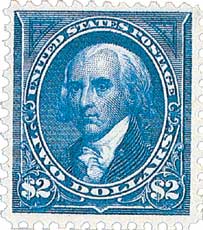
James Madison was born on March 16, 1751, in Port Conway, Virginia. James was the oldest of 12 children, although only seven would reach adulthood. He was a weak and sickly child, unable to spend much time being active, but was an avid reader.
Madison attended the College of New Jersey (now Princeton University) from 1769-71, completing a four-year degree in just two years. For a year after graduating, he studied closely with the school’s president, John Witherspoon, earning the honor of being Princeton’s first graduate student (sometimes referred to as America’s first graduate student).
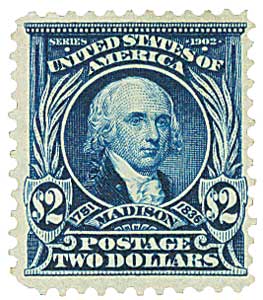
Following an illness that lasted for more than a year, Madison joined the pro-independence movement. He was appointed to a seat on Virginia’s Committee of Safety in 1774. As a member of the Virginia Convention, Madison helped create the state’s constitution in 1776. From 1776 to 1779, Madison served in the Virginia State legislature, where he developed a close relationship with Thomas Jefferson. Madison quickly became a respected figure in Virginia politics, and was key in the creation of the Virginia Statute for Religious Freedom (a precursor to the first amendment). He drafted the document that dissolved the Church of England in the U.S. and removed the state’s power to intervene on religious issues.
In 1780, at the age of 29, Madison was elected to the Continental Congress – the country’s youngest congressman. Though he was shy at first, his passion for politics quickly established him as a great debater and legislator. Madison advocated a stronger central government than what had been established by the Articles of Confederation.
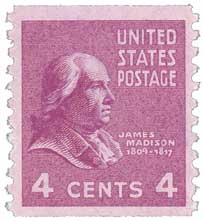
When commerce issues came to a head between Virginia and Maryland in 1786, Madison encouraged representatives from every state to come together to work out their differences. Although only representatives from five states attended, they discovered they shared many concerns that could be resolved by mutual cooperation. Following the success of this convention, a second was planned to take place the following May in Philadelphia. At last, Madison’s goal of strengthening the central government was soon to be addressed.
In May 1787, Madison arrived at the Philadelphia Constitutional Convention early and with a number of resources to share with his fellow delegates. His plan was to create a new central government with stronger powers, an elected chief executive with the power to veto legislation, a federal judiciary branch, and a two-chambered legislature. While each branch would have certain set responsibilities, they would each also have the opportunity to take part in checks and balances of each other’s actions. Madison’s plan was an overwhelming success.
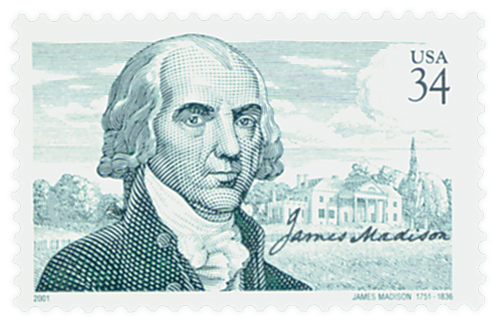
Madison lobbied extensively to ensure the constitution’s passage by the states. Along with Alexander Hamilton and John Jay, Madison published a series of 85 essays called “The Federalist Papers.” They explained in detail how the Constitution would work. Madison is credited with writing 26 of these essays. Despite opposing arguments from Patrick Henry, James Monroe, and George Mason, the Constitution was ratified by a vote of 89 to 79. The U.S. Constitution became the supreme law of America.
In 1789, Madison became one of the House of Representative’s first great legislators. One of his major tasks in this role was to create a bill of rights, which he opposed at first. He eventually gave in to the Federalists’ pleas and began working on a series of amendments, which were based on proposals he received from each state that wished to contribute. The Bill of Rights was completed and ratified in December 1791.
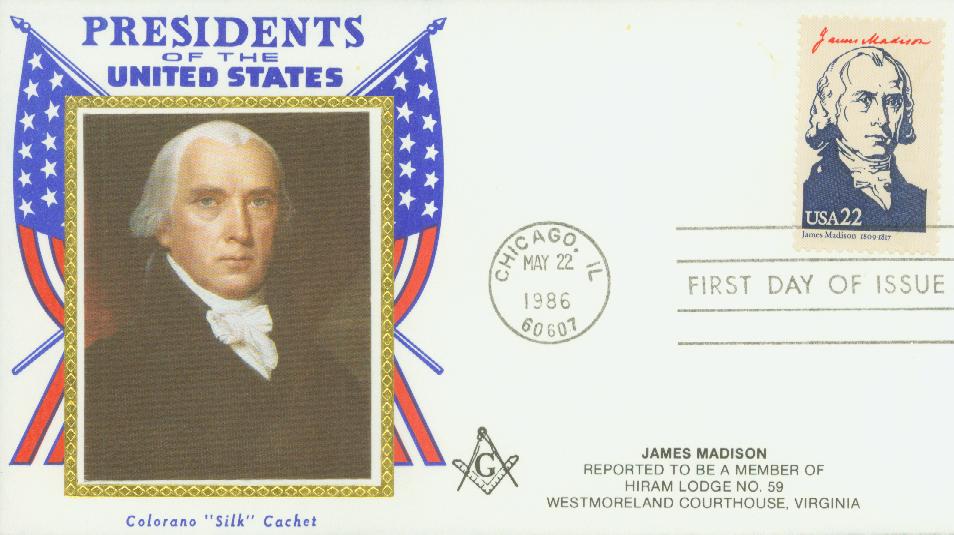
Following a brief time off, during which which he married Dolley Payne Todd, Madison returned to politics. He worked with the Virginia legislature until Thomas Jefferson won the Presidential election of 1800 and appointed him U.S. Secretary of State. Together, Madison and Jefferson were able to implement several important changes. They obtained the Louisiana Territory from France for $15 million in 1803. They also enjoyed a victory at sea over Barbary pirates, who had demanded payment from ships traveling in the Mediterranean Sea.
Due to the popularity of Jefferson and the Democratic-Republican Party, Madison easily won the election of 1808 against Charles Cotesworth Pinckney. Madison’s inaugural ball – the nation’s first – was an impressive event that followed his inaugural address, in which he declared that the U.S. would not be intimidated by foreign encroachment.
Despite Madison’s attempts to defend U.S. interests, England and France continued to disrupt American shipping. England often forced American sailors into their service with claims that the U.S. was weak and no longer united. When further diplomatic options seemed impossible, Madison declared war against Great Britain in June 1812.
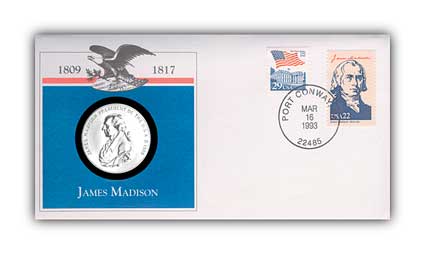
“Mr. Madison’s War” took its toll on America. After it ended two years later, America displayed a stronger national unity, and many consider it a victory. The young country was able to defend itself against a major international power and was still intact. America proved itself as a significant naval power capable of protecting its own borders, even against one of the world’s most powerful empires. Both Madison and America became more confident. The balance of his administration was dedicated to improving the national situation. Madison supported the creation of the Second National Bank (which he opposed prior to his presidency). He imposed small taxes on imports to better American commerce, and encouraged plans to improve roads and canals. Madison’s last two years in office were viewed by many as his most effective and by far his most popular. When he left office in 1817, America was on an upward course for improvement, expansion, and prosperity.
At the end of his term, Madison and his wife Dolley retired to Montpellier, Virginia, where he was active as a “gentleman farmer” (not-for-profit hobbyist farmer). He served as an adviser to James Monroe and a rector at the University of Virginia following Thomas Jefferson’s death in 1826. Madison spent much of his retirement writing and revising papers chronicling his career.
Madison continued to share his political ideas in retirement. He spoke at the 1829 Virginia Convention, in an attempt to increase voters’ rights and oppose slavery. James Madison died on June 28, 1836 – the last of the Founding Fathers.
34¢ James Madison
City: New York, NY
Quantity: 32,000,000
Printed by: Banknote Corporation of America
Printing Method: Lithographed and engraved
Perforations: Serpentine Die Cut 11 x 11 ¼
Color: Green and black
Happy Birthday, James Madison

James Madison was born on March 16, 1751, in Port Conway, Virginia. James was the oldest of 12 children, although only seven would reach adulthood. He was a weak and sickly child, unable to spend much time being active, but was an avid reader.
Madison attended the College of New Jersey (now Princeton University) from 1769-71, completing a four-year degree in just two years. For a year after graduating, he studied closely with the school’s president, John Witherspoon, earning the honor of being Princeton’s first graduate student (sometimes referred to as America’s first graduate student).

Following an illness that lasted for more than a year, Madison joined the pro-independence movement. He was appointed to a seat on Virginia’s Committee of Safety in 1774. As a member of the Virginia Convention, Madison helped create the state’s constitution in 1776. From 1776 to 1779, Madison served in the Virginia State legislature, where he developed a close relationship with Thomas Jefferson. Madison quickly became a respected figure in Virginia politics, and was key in the creation of the Virginia Statute for Religious Freedom (a precursor to the first amendment). He drafted the document that dissolved the Church of England in the U.S. and removed the state’s power to intervene on religious issues.
In 1780, at the age of 29, Madison was elected to the Continental Congress – the country’s youngest congressman. Though he was shy at first, his passion for politics quickly established him as a great debater and legislator. Madison advocated a stronger central government than what had been established by the Articles of Confederation.

When commerce issues came to a head between Virginia and Maryland in 1786, Madison encouraged representatives from every state to come together to work out their differences. Although only representatives from five states attended, they discovered they shared many concerns that could be resolved by mutual cooperation. Following the success of this convention, a second was planned to take place the following May in Philadelphia. At last, Madison’s goal of strengthening the central government was soon to be addressed.
In May 1787, Madison arrived at the Philadelphia Constitutional Convention early and with a number of resources to share with his fellow delegates. His plan was to create a new central government with stronger powers, an elected chief executive with the power to veto legislation, a federal judiciary branch, and a two-chambered legislature. While each branch would have certain set responsibilities, they would each also have the opportunity to take part in checks and balances of each other’s actions. Madison’s plan was an overwhelming success.

Madison lobbied extensively to ensure the constitution’s passage by the states. Along with Alexander Hamilton and John Jay, Madison published a series of 85 essays called “The Federalist Papers.” They explained in detail how the Constitution would work. Madison is credited with writing 26 of these essays. Despite opposing arguments from Patrick Henry, James Monroe, and George Mason, the Constitution was ratified by a vote of 89 to 79. The U.S. Constitution became the supreme law of America.
In 1789, Madison became one of the House of Representative’s first great legislators. One of his major tasks in this role was to create a bill of rights, which he opposed at first. He eventually gave in to the Federalists’ pleas and began working on a series of amendments, which were based on proposals he received from each state that wished to contribute. The Bill of Rights was completed and ratified in December 1791.

Following a brief time off, during which which he married Dolley Payne Todd, Madison returned to politics. He worked with the Virginia legislature until Thomas Jefferson won the Presidential election of 1800 and appointed him U.S. Secretary of State. Together, Madison and Jefferson were able to implement several important changes. They obtained the Louisiana Territory from France for $15 million in 1803. They also enjoyed a victory at sea over Barbary pirates, who had demanded payment from ships traveling in the Mediterranean Sea.
Due to the popularity of Jefferson and the Democratic-Republican Party, Madison easily won the election of 1808 against Charles Cotesworth Pinckney. Madison’s inaugural ball – the nation’s first – was an impressive event that followed his inaugural address, in which he declared that the U.S. would not be intimidated by foreign encroachment.
Despite Madison’s attempts to defend U.S. interests, England and France continued to disrupt American shipping. England often forced American sailors into their service with claims that the U.S. was weak and no longer united. When further diplomatic options seemed impossible, Madison declared war against Great Britain in June 1812.

“Mr. Madison’s War” took its toll on America. After it ended two years later, America displayed a stronger national unity, and many consider it a victory. The young country was able to defend itself against a major international power and was still intact. America proved itself as a significant naval power capable of protecting its own borders, even against one of the world’s most powerful empires. Both Madison and America became more confident. The balance of his administration was dedicated to improving the national situation. Madison supported the creation of the Second National Bank (which he opposed prior to his presidency). He imposed small taxes on imports to better American commerce, and encouraged plans to improve roads and canals. Madison’s last two years in office were viewed by many as his most effective and by far his most popular. When he left office in 1817, America was on an upward course for improvement, expansion, and prosperity.
At the end of his term, Madison and his wife Dolley retired to Montpellier, Virginia, where he was active as a “gentleman farmer” (not-for-profit hobbyist farmer). He served as an adviser to James Monroe and a rector at the University of Virginia following Thomas Jefferson’s death in 1826. Madison spent much of his retirement writing and revising papers chronicling his career.
Madison continued to share his political ideas in retirement. He spoke at the 1829 Virginia Convention, in an attempt to increase voters’ rights and oppose slavery. James Madison died on June 28, 1836 – the last of the Founding Fathers.













